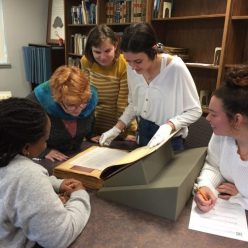by Kathleen Smith, Special Collections Metadata Specialist
Today the world has been greatly affected by the COVID-19 pandemic which has infected millions of people world-wide. Scientists are exploring the origins of this virus and what causes it to thrive in order to develop vaccines or even develop forms of treatment (i.e. plasma therapy). Until there is a cure or a way to treat COVID-19, measures such as vaccination, washing hands, wearing masks, practicing social distancing, is the only way to fight it.
There was a similar deadly virus which killed and crippled people-mostly young worldwide, this virus was known as poliovirus which caused a disease known as poliomyelitis or called by its shorter form-polio. Poliomyelitis was an infectious disease that was spread through contaminated food and water, causing varying damage to the muscles of the head, neck, and diaphragm, as well as spinal damage. Paralysis, muscle deformities, and breathing difficulties were the effects left on those who were infected.
Even though poliomyelitis existed back into ancient times, the first reports of polio were recorded in the latter half of the Nineteenth Century, which included an on outbreak in Vermont infecting 132 people and killing eighteen. In the summer of 1916, a major polio epidemic broke out in the United States, starting in Brooklyn, which infected 27,000 across the United States, along with 6,000 deaths (2,000 of the deaths were in New York City). As a result, affected families and individuals were quarantined, movie theaters and swimming pools were closed, public gatherings were a rarity, and young people were told to avoid drinking from water fountains and to not to go to the beach. After the 1916 outbreak, there would be a polio epidemic each summer with the most serious cases occurring during the 1940s and 1950s. The worst known outbreak was in the United States was in 1952 with 57,628 cases which resulted in 3,145 deaths and 21,269 with mild to severe paralysis.
Over the years efforts would be made, such as improvement of sanitation practices, trying to finding a vaccine, as well as an developing an array of treatments to treat the effects of the virus such as the iron lung, the rocking bed, antibody serum treatment, splints, and hot compresses. A breakthrough came in 1952 medical researcher Jonas Salk developed an injectable vaccine containing a dose of killed poliovirus. The vaccine was put in use worldwide in 1955. The number of polio cases went down dramatically in the United States: 35,000 in 1953; 5,600 in 1957; 161 in 1961. An equally successful oral vaccine developed by Albert Sabin in 1957 and licensed in 1962, used a live but weakened virus, and gradually replaced the Salk vaccine due to it being easier to administer and less expensive in cost. Today there are fewer than 1,000 cases in the United States and the world. I hope the same can be done for COVID-19.
In the 1950s polio greatly affected the local Hampton Roads population young and old. A news show airing on the fledgling television station WTAR-TV, called “Tidewater Viewpoint” featured stories/segments on those who were affected by polio in Hampton Roads. These segments are part of the WTAR News Collection in the ODU Libraries Digital Collections.
Sources:
https://coronavirus.jhu.edu/map.html
https://en.wikipedia.org/wiki/Polio
https://en.wikipedia.org/wiki/History_of_polio
https://en.wikipedia.org/wiki/Timeline_of_polio




